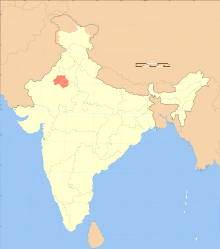Shekhawati
The Shekhawati is an approximately 14,000 km² historical region in the northeast of the Indian state of Rajasthan .
geography
The mostly flat, about 300 to 400 m high, semi-arid Shekhawati region forms the transition from the north Indian Ganges and Yamuna plains to the semi-deserts and deserts of Rajasthan and is located about 250 km southwest of Delhi and about 140 km northwest of Jaipur . The districts of Jhunjhunu and Sikar belong to it in the narrower sense , but parts of the districts of Nagaur and Churu are usually also included. The largest cities of the Shekhawati in the narrower sense are Sikar (approx. 245,000 inhabitants), Jhunjhunu (approx. 120,000 inhabitants), Fatehpur (approx. 95,000 inhabitants), Nawalgarh (approx. 65,000 inhabitants) and Mandawa (approx. 25,000 inhabitants). There are no rivers and lakes in the region; Drinking water and water for irrigation of the fields is mostly pumped up from about 30 to 60 m deep wells . In the summer months of May, June and July until the beginning of the monsoon season , temperatures rise to over 40 ° C during the day; In cloudy winter nights, the thermometer can drop to 0 ° C.
population
The number of residents can be estimated at around 3 million (Jhunjhunu and Sikar districts) and around 5 million (including parts of Nagaur and Churu districts). Most of the residents claim to be of Rajput ancestry, others are members of the Jats , but there are also many casteless day laborers. They speak a regional dialect ( Shekhawati ), but also Hindi and sometimes some English in the cities . The literacy rate is among the highest on the Indian subcontinent . As is customary in India, the male proportion of the population exceeds the female population by around 5 to 10 percent.
economy

The vast majority of the population traditionally live from agriculture, i. H. from the cultivation of cereals (rice, wheat), lentils , pumpkins and vegetables after the annual monsoon season ; there are both large estates ( jagir ) and small village farmers. Characteristic of the Shekhawati are the numerous wells for field irrigation - once operated with the help of donkeys or camels; today gasoline-powered pumps are mostly used because of the lowering of the water table . Crafts, small businesses and services of all kinds dominate the cities; In addition, there are health care facilities (doctors, hospitals, pharmacies) and training (schools, colleges, etc.). In the 18th and 19th centuries, many merchant families from Marwar settled in the region and controlled the caravan trade on a little-known side route of the Silk Road ; some of them achieved considerable wealth and built the typical regional havelis for themselves and their families . With the diversion of trade flows to the safer and cheaper sea route via the ports of Surat and Bombay by the British in the late 19th and early 20th centuries, the Shekhawati's economic heyday came to an end.
history
The Shekhawati region is named after Rao Shekha (ruled 1445–1488), who succeeded in a crisis situation of the Sultanate of Delhi and against the resistance of numerous Rajput princes, an independent empire with the capital Amarsar (today a village approx. 145 km to the west from Jaipur). Despite countless conflicts, his successors also managed to maintain the de facto autonomy of the region for centuries, even though the maharajas of Amber and Jaipur were nominal overlords.
Attractions
In the Shekhawati region, which is about 95% inhabited by Hindus, there are no temples, mosques or palaces of outstanding historical or cultural importance; The only ones worth mentioning are the Dadhimati Mata Temple near Nagaur, the new Raghu-Nath Temple in Mandawa, the Fort of Sikar and the palaces of Mandawa , Alsisar (now hotels) and Nagaur. The main attractions are both inside and brightly painted merchants' houses ( havelis ) from the period of the 18th and 19th centuries, most of which, however - are bad fall - because of the exodus of the former owners and the arrival of former rural residents. In the city of Fatehpur there is a well-preserved stepwell with corner pavilions ( chhatris ).
Web links
- Shekhawati - photos + description of several places
- Shekhawati - photos + description of several places
- Shekhawati - Info (English)
- Shekhawati - Info (English)
- Shekhawati, Mandawa - video
- Shekhawati, Fatehpur - video
- Drive via Fatehpur to Mandawa - video


